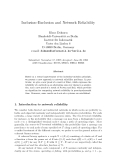
ISSN 1859-1531 - TẠP CHÍ KHOA HỌC VÀ CÔNG NGHỆ - ĐẠI HỌC ĐÀ NẴNG, VOL. 23, NO. 1, 2025 1
ADVANCE PATH LOSS MODEL FOR LORAWAN COVERAGE ESTIMATION
MÔ HÌNH SUY HAO NÂNG CAO TRONG ƯỚC TÍNH VÙNG PHỦ MẠNG LORAWAN
Van Lic Tran*, Tran Dang Khoa Phan, Tran Thi Minh Hanh, Vu Van Thanh,
Thai Van Tien, Thai Vu Hien, Tran Anh Kiet
The University of Danang - University of Science and Technology, Vietnam
*Corresponding author: tvlic@dut.udn.vn
(Received: October 25, 2024; Revised: December 18, 2024; Accepted: December 26, 2024)
DOI: 10.31130/ud-jst.2025.456E
Abstract - This paper demonstrates that, using multiple data
points around each gateway allows for the creation of accurate
coverage heat maps by using a proposed LoRaWAN coverage
estimation algorithm. This method effectively identifies areas
with varying signal strength across Da Nang City, highlighting
where additional gateways are needed to improve network
reliability. Unlike previous studies, this research considers
environmental factors such as topography and urban structures,
enhancing prediction accuracy. This technique would be essential
for optimizing essential for optimizing LPWAN deployments and
ensuring efficient resource utilization. Future efforts will focus on
refining neural network models and integrating real-time data to
support scalable Smart City solutions and a more robust
connectivity infrastructure, with this work planned for future
research.
Tóm tắt - Bài báo này chứng minh rằng, việc sử dụng nhiều điểm
dữ liệu xung quanh mỗi gateway cho phép tạo ra các bản đồ nhiệt
thể hiện vùng phủ sóng chính xác nhờ thuật toán ước lượng phủ
sóng LoRaWAN được đề xuất. Phương pháp này được áp dụng
để xác định hiệu quả các khu vực có cường độ tín hiệu khác nhau
tại thành phố Đà Nẵng, làm nổi bật những vị trí cần thêm gateway
để cải thiện độ tin cậy của mạng. Khác với các nghiên cứu trước
đây, nghiên cứu này xem xét các yếu tố như môi trường, địa hình
và cấu trúc đô thị, giúp nâng cao độ chính xác của dự đoán vùng
phủ sóng. Kỹ thuật này rất quan trọng để tối ưu hóa việc triển khai
mạng LPWAN và đảm bảo sử dụng tài nguyên hiệu quả. Các
nghiên cứu trong tương lai sẽ tập trung vào việc tinh chỉnh các
mô hình mạng nơ-ron và tích hợp dữ liệu thời gian thực để hỗ trợ
các giải pháp thành phố thông minh và có thể mở rộng cơ sở hạ
tầng kết nối một cách nhanh chóng.
Key words - LPWAN; LoRaWAN; LoRa; path loss; coverage.
Từ khóa - LPWAN; LoRaWAN; LoRa; suy hao; vùng phủ.
1. Introduction
Low Power Wide Area Networks (LPWANs) have
recently garnered significant attention in Southeast Asia
due to their distinctive qualities, including low power
consumption, extensive coverage, and cost-effective
deployment. Among these, LoRaWAN stands out as a
globally standardized LPWAN technology, thanks to the
efforts of the LoRa Alliance. LoRaWAN is particularly
suitable for various IoT applications such as Smart
Tourism, Smart Agriculture, and Smart Cities [1]. Da
Nang, the fifth-largest city in Vietnam with over one
million inhabitants, serves as the commercial and
intellectual hub of Central Vietnam and is an ideal
candidate for implementing such technologies.
To deploy numerous LoRaWAN gateways around a
city, for example in a smart city application, accurately
estimating LoRaWAN network coverage is crucial for
effective planning and deployment, especially in urban
and large areas. This estimation allows for the strategic
placement of gateways to ensure optimal network
performance and coverage. By understanding the
coverage areas and potential signal gaps, planners can
determine the most efficient locations for gateways to
maximize connectivity and minimize interference. This
approach not only improves the reliability and quality of
the network but also ensures cost-effectiveness by
preventing the over-deployment of gateways.
Furthermore, accurate coverage estimation helps
anticipate and address environmental factors and
topographical challenges that may affect signal strength
and reliability. Ultimately, thorough coverage estimation
is essential for the successful implementation and
scalability of LoRaWAN networks, supporting various
IoT applications and enhancing the infrastructure of smart
cities [1].
A critical aspect of deploying the Smart City model
involves ensuring comprehensive network coverage across
the entire city. The study in [2] investigates LoRaWAN
network coverage through real-life measurements
conducted in Oulu, Finland. This research measured the
received signal strength from various locations within the
city, demonstrating a maximum communication range of
over 15 km on land and nearly 30 km on water. Another
study [3] employs a combination of real-world
measurements and high-fidelity simulations to show that
three gateways are sufficient to cover a dense urban area
within an approximately 15 km radius.
Research by [4] adopts a different approach by
evaluating multiple simulation tools, including Xirio,
Coverage Prediction and Analysis Software, Radio
Mobile, and Tower Coverage, to determine the most
suitable tool for LPWAN networks. Their findings indicate
that the Xirio tool offers the most accurate coverage
simulation for LoRaWAN technology. However, they
suggest that the final evaluation should integrate
simulation results with real-world measurements.
The study in [5] focuses on the coverage and capacity
analysis of LoRaWAN for typical massive IoT applications
in both urban and suburban areas, utilizing the simulation
tool Forsk Atoll 3.3.2. Similarly, the research in [6]







